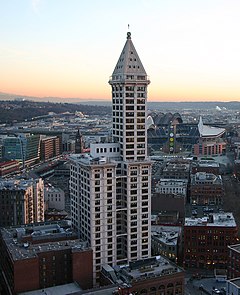Smith Tower
| Smith Tower | |
|---|---|

Smith Tower as seen from the Pacific Building.
|
|
| Alternative names | L.C. Smith Building |
| Record height | |
| Tallest in Seattle and Washington state from 1914 to 1962 | |
| Preceded by |
Hoge Building (Seattle) Key Bank Center (Tacoma/statewide) |
| Surpassed by | Space Needle |
| General information | |
| Type | Commercial offices Residential |
| Location | 500 Second Avenue Pioneer Square Seattle, Washington |
| Coordinates | 47°36′08″N 122°19′54″W / 47.602092°N 122.331803°WCoordinates: 47°36′08″N 122°19′54″W / 47.602092°N 122.331803°W |
| Construction started | 1911 |
| Completed | 1914 |
| Cost | US$1.5 million |
| Owner | Unico Properties |
| Height | |
| Antenna spire | 484 ft (148 m) |
| Roof | 462 ft (141 m) |
| Technical details | |
| Floor count | 38 |
| Floor area | 28,275 m2 (304,350 sq ft) |
| Lifts/elevators | 8 |
| Design and construction | |
| Architect | Gaggin & Gaggin |
| Main contractor | E.E. Davis Company |
| Designated | March 11, 1987 |
| References | |
Smith Tower is a skyscraper in Pioneer Square in Seattle, Washington. Completed in 1914, the 38-story, 484 ft (148 m) tower is the oldest skyscraper in the city, and was among the tallest skyscrapers outside New York City at the time of its completion. It was the tallest office building west of the Mississippi River until the completion of the Kansas City Power & Light Building in 1931. It remained the tallest building on the West Coast for nearly half a century until the Space Needle overtook it in 1962.
Smith Tower is named after its builder, firearm and typewriter magnate Lyman Cornelius Smith, and is a designated Seattle landmark.
During a trip to Seattle in 1909, Smith planned to build a 14-story building in Seattle. His son, Burns Lyman Smith, convinced him to build instead a much taller skyscraper to steal the crown from rival city Tacoma's National Realty Building as the tallest west of the Mississippi River. Construction began in 1911. Although Smith did not live to see it, the building was completed in 1914 to a height of 143 m (469 ft) from curbside to the top of the pyramid, with a pinnacle height of 159 m (522 ft). Smith Tower opened to the public on July 4, 1914. Over 4,000 Seattleites rode to the 35th floor on opening day. The Chinese Room, whose name was retired following the 2016 renovation, derived from the carved teak ceiling and blackwood furniture that adorned the room on opening. The room was furnished by the last Empress of China, Cixi. Furnishings include the famous Wishing Chair. The chair incorporates a carved dragon and a phoenix, which, when combined, portends marriage. According to folklore, any wishful unmarried person who sits in it would be married within a year. The legend came true for Smith's daughter, who married in the Chinese Room itself.
Ivar Haglund of Ivar's restaurant fame bought the tower for $1.8 million in 1976. The Samis Foundation acquired the tower in 1996. In 2006, the building was purchased by Walton Street Capital. The building has been renovated twice, in 1986 and in 1999.
...
Wikipedia
